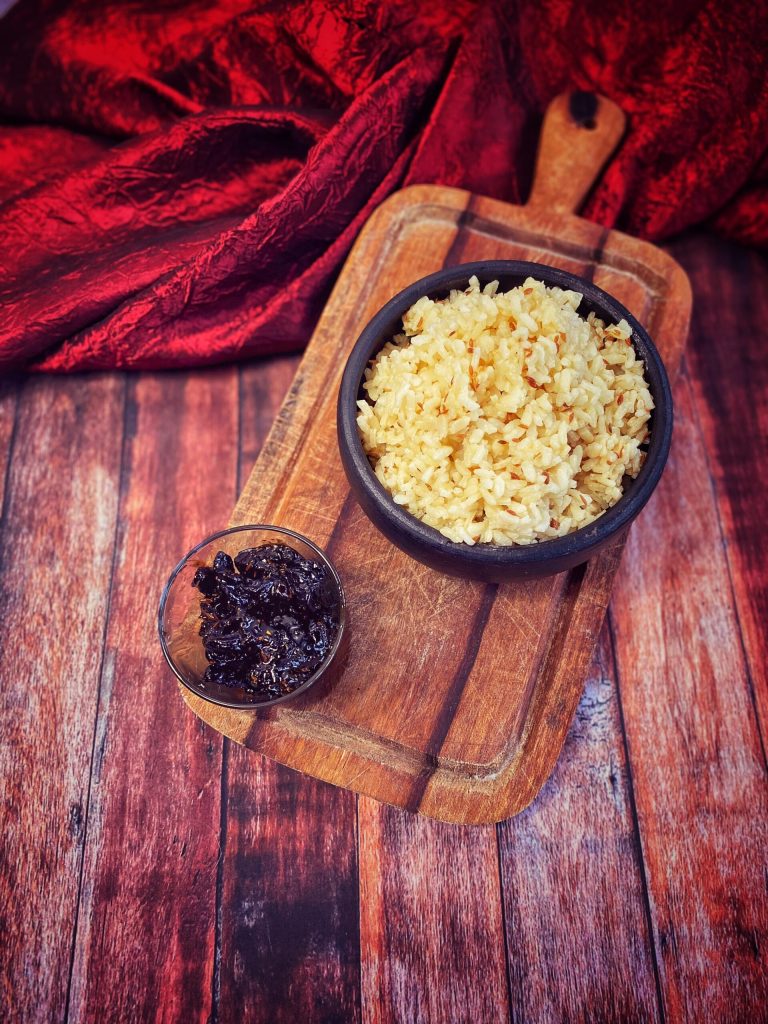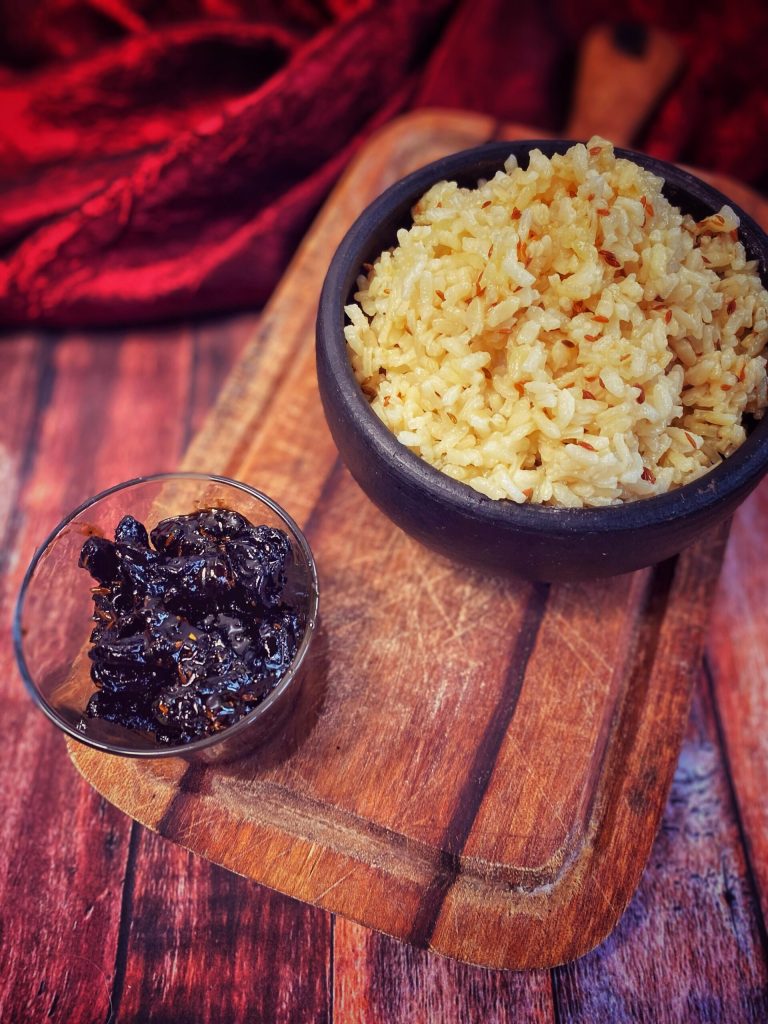The Jeera rice, or Jeera Bhaat, is an Indian dish consisting of rice and cumin seeds. “Jeera” is the Hindi term for cumin seeds, while the word Bhaat derives from the Sanskrit word Bhakta meaning “boiled rice”.
Very popular in the Indian subcontinent and most commonly used as a daily rice dish.
The ingredients used are: rice, cumin seeds, vegetable oil, onions, salt, and coriander leaves.
I accompanied it with Imli chutney, or tamarind chutney (Imli is the Hindi word for tamarind).
This chutney is often used for North Indian chaat snacks such as dahi vada, samosa chaat, aloo tikki chaat etc.

- Difficulty: Easy
- Cost: Very economical
- Preparation time: 5 Minutes
- Portions: 2People
- Cooking methods: Other
- Cuisine: Indian
- Seasonality: All seasons
Ingredients
- 1/2 cup Basmati rice
- 1 cup ml water
- 1 1/2 teaspoon cumin
- 1 tablespoon coriander powder
- to taste vegetable oil (or ghee)
- 1/2 onion
- to taste salt
- to taste fresh coriander
- 8 oz g tamarind
- 1/4 cup g jaggery
- 1/4 teaspoon coriander seeds
- 1/2 teaspoon cumin
- 1/2 teaspoon ginger powder
- 1/4 teaspoon chili
- 1/2 teaspoon asafoetida
- to taste black salt
- to taste peanut oil (or sesame oil)
Steps
Rinse the rice.
Fry the cumin seeds in hot oil or ghee.
Add the onion, rice, and salt.
Pour the water and let it boil with the lid covered on high flame until all the water is absorbed.
Jeera rice is generally garnished with finely chopped fresh coriander leaves.

Soak the tamarind in water overnight, then squeeze the juice.
Heat the oil, add the cumin, ginger, asafoetida, jaggery, chili, coriander, black salt, and tamarind.
Cook for about 5 minutes until the consistency thickens.

FAQ (Questions and Answers)
What is a Chutney?
Chutney is a spread typically associated with the cuisines of the Indian subcontinent.
The chutneys are made in a wide variety of forms, such as tomato condiment, ground peanut side dish, yogurt or curd, cucumber, spicy coconut, spicy onion, or mint sauce.
In India, chutney refers indiscriminately to fresh and pickled preparations; however, different Indian languages use the word only for fresh preparations.
It can be ground with a mortar and pestle or with an ammikkal (Tamil).
The spices are then added and ground, usually in a particular order; the wet paste thus obtained is sautéed in vegetable oil, usually gingelly (sesame) or peanut oil.
A common variant in Anglo-Indian cuisine, originating from the Anglo-Indians at the time of the British Raj, uses a sour fruit like spicy apples, rhubarb, or pickled plums, made milder by an equal weight of sugar (usually demerara, turbinado, or cane sugar to replace jaggery in some sweet Indian chutneys).
Vinegar was added to the English chutney recipe, traditionally aiming to give long shelf life so that autumn fruits could be preserved for use throughout the year (as are jams, jellies, and pickles) or to be sold as a commercial product.
Indian pickles use mustard oil as the pickling agent, but Anglo-Indian style chutney uses malt or cider vinegar which produces a milder product.
In Western cuisine, chutney is often consumed with hard cheese or with cold meats and poultry, typically in pub cold lunches.
The Major Grey’s Chutney is a type of sweet and spicy chutney popular in the United States. Reportedly, the recipe was created by a 19th-century British Army officer of the same name (probably apocryphal) who supposedly resided in the Raj for a time.
Its characteristic ingredients are: mango, raisins, vinegar, lime juice, onion, tamarind extract, sweetener, and spices.
Several companies produce a Major Grey’s Chutney, in India, the United Kingdom, and the United States.What spices are used in chutneys?
The spices commonly used in chutneys are: fenugreek, coriander, cumin, and asafoetida (hing).
Other ingredients and classic combinations include: coriander, chili, mint (coriander and mint chutneys are often called हरा hara chutney, Hindi for “green”), Tamarind or imli (often called meethi chutney, as मिठाई meethi in Hindi means “sweet”), soith (or saunth, made with dates and ginger), coconut, onion, dry plum, tomato, red chili, green chili, mango, lime (made with whole and unripe limes), garlic, coconut, peanuts, dahi (yogurt), green tomato, dhaniya pudina (coriander and mint), peanuts (shengdana chutney in Marathi), ginger, red chili powder, onion and tomato, coconut and mint, apricot.
In Trinidad and Tobago, chutneys are mostly made with green mango, coconut, or tamarind.

